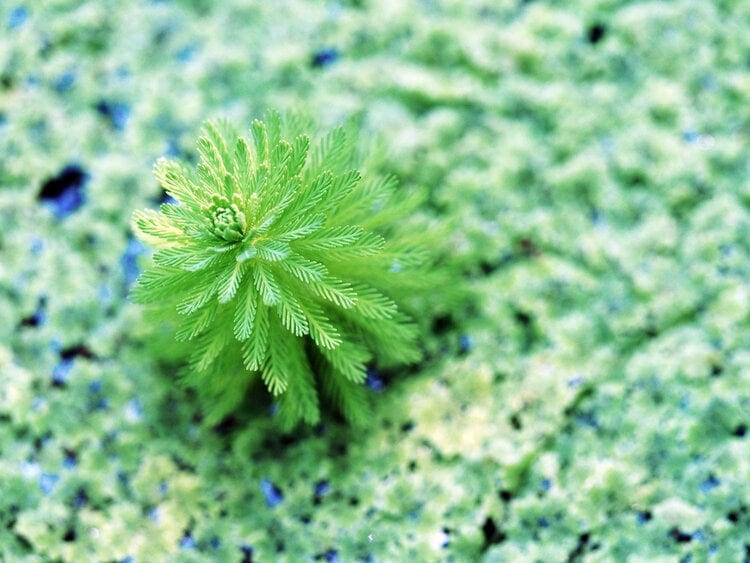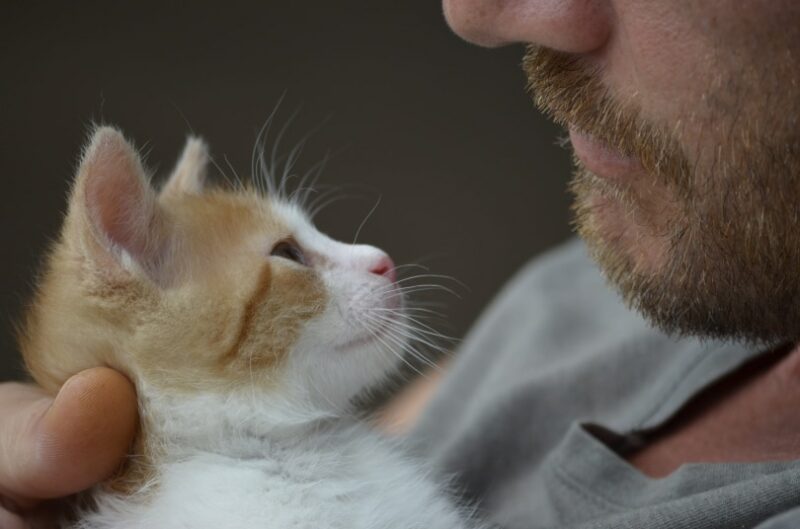
Parrot feather (Myriophyllum aquaticum) is a fast-growing and versatile aquatic plant that is considered a highly invasive species. This lush green plant looks great in freshwater aquariums and can grow well under the right conditions. It is a subtropical species that thrives best in warm water and can easily be cared for which makes it an ideal species of aquatic plant for beginners.
There are several different species of Myriophyllum, but the most popular species is the parrot feather variety that was first brought from Central and South America during the 1800s. It is now one of the top five most invasive plants found globally. It is a hardy plant that can withstand a variety of different water conditions while thriving in most freshwater aquariums with minimal care requirements.
 Useful Information About Parrot Feather
Useful Information About Parrot Feather
| Family Name: | Haloragaceae |
| Common Name: | Watermilfoil |
| Origin: | South America |
| Color: | Light green |
| Size: | 3–5 feet tall |
| Growth Rate: | Moderately fast |
| Care Level: | Beginner-friendly |
| Lighting: | Moderate to high |
| Water Conditions: | Freshwater, tropical, and temperate water temperatures |
| Minimum Tank Size: | 10 gallons |
| Supplements: | CO2 and fertilizers are optional |
| Placement: | Background, foreground |
| Propagation: | Spreads by floating pieces of rhizomes |
| Compatibility: | Other foreground plants |
Parrot Feather Appearance
Parrot feather has a green coloration with a slightly blue tint. It consists of four to six feathery whorls that grow from the stem and sometimes protrude from the surface of the aquarium’s water. When the plant is mature, it grows small white flowers at the base of the newly emerging leaves in the springtime. However, parrot feather flowering is a rare occurrence. This plant is more likely to flower when kept in the right conditions for years and has grown and developed well in the aquarium.
Parrot feathers can either grow above the waterline or be fully submerged in water. When the plant is fully emerged in water, you will notice that emergent leaves and stems start to overgrow from the waterline. This can help to add more liveliness to an aquarium and the parrot feather plant looks quite attractive.
When this plant grows fully underwater, it can look like a thick carpeting plant with a mixture of deep green leaves and stems. The long and narrow stems themselves can grow up to five inches. Each leaf of the parrot feather plant can reach around half an inch in size and becomes a darker shade of green when it is exposed to water.

Where to Find It?
Since parrot feather is considered an invasive species in some states, some local fish stores are not permitted to sell this plant. However, in states where this plant is not considered invasive, you can find it at much local fish store that sells a variety of different aquatic plants. This inexpensive plant is not considered rare and can easily be found in pet stores or online websites that sell live plants.
General Care
Caring for your parrot feather plant in your aquarium is easy and it does not need any specific fertilizers and added CO2 in the aquarium to thrive. This plant should only be placed in an aquarium that has been fully cycled through the nitrogen cycle so that the water parameters are ideal. Parrot feather does not do well with high levels of ammonia as this can cause the plant to suffer from root and leaf burn which will cause your parrot feather to slowly melt and die off.
The ideal water conditions for this plant are to have a nitrate level between 5 to 15 ppm (parts per million) and a nitrite and nitrate level at 0 ppm. Parrot feathers will use the nitrates in the water for growth which is produced by waste and excess nutrients in the aquarium’s water column.
The most necessary fertilizer for this plant is to add an iron-rich fertilizer that also contains small amounts of minerals. This can help prevent this plant from turning white from a nutrient deficiency. If you choose to plant your parrot feather in an iron-rich substrate, then you do not have to worry about adding an iron fertilizer.
Parrot feather requires regular pruning and trimming of any dead leaves or damaged stems. This helps to keep the plant looking great in your aquarium and encourages the plant to grow more.

Habitat, Tank Conditions & Setup
Planting Tips
Parrot feathers can either be left to float in an aquarium or planted. Whether it is planted or left to float at the water’s surface, this plant needs nutrients in the water to be able to grow and survive. The roots should ideally be planted in a substrate such as soil, quartz, or a type of sandy substrate.
If you choose to cover your parrot feathers’ roots in the substrate, you can also use a root tab to encourage the plant to grow and get much-needed nutrients to encourage it to start growing.
Parrot feather grows through a process called fragmentation where the roots multiply, but it can also spread through stems that grow underground. You can also cut a stem from the plant and roots should soon start to form from the severed root to form a new plant.

Benefits of Having Parrot Feather in Your Aquarium
Concerns About Parrot Feather
There is a concern that mosquitoes like to lay their eggs near these plants if they are floating on the surface of the plant’s growing leaves at the surface of the water. This can increase the number of mosquitoes that enter your home, which can become a nuisance. It can also become a more prominent problem if you have this plant growing in your pond. Some species of fish (koi, goldfish, or guppies) will enjoy eating the larvae and any mosquitoes that land on the surface of the water.
Since parrot feather is an invasive plant, it grows rapidly and should be kept away from waterways, so it does not invade your region’s water sources and compete with other plants that naturally grow there. First, make sure your state allows parrot feathers to be grown because this plant’s rapid growth can pose a problem to natural species of plants.
Parrot feather also uses a lot of nitrates and nutrients from the water which can cause other plants to compete for nutrients with this plant, especially if the aquarium has a low bioload and is not supplemented with fertilizers.
 Final Thoughts
Final Thoughts
When grown appropriately, parrot feathers will thrive in ideal conditions with a good amount of lighting, nutrients, and good water quality. The deep-green leaves look great in planted aquariums and can help to bring life to an aquatic environment.
This plant is quite versatile and hardy which makes it perfect for beginners to grow in their aquarium amongst a variety of different fish and invertebrates. You will find that parrot feather grows quite fast, and you might need to trim them more than other plants in your aquarium to prevent them from overgrowing.
Featured Image Credit: ANGHI, Shutterstock

 Useful Information About Parrot Feather
Useful Information About Parrot Feather






